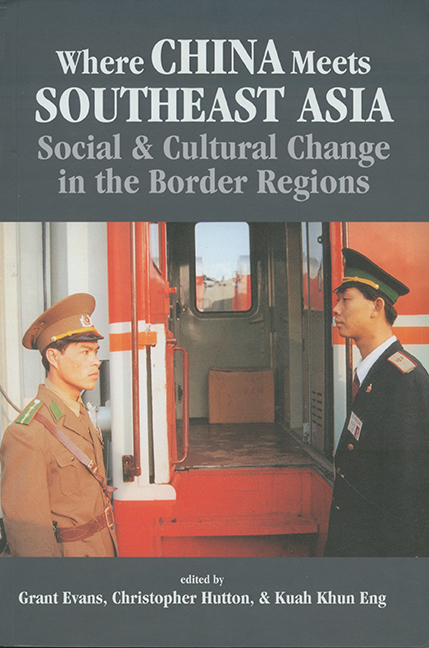Book contents
- Frontmatter
- Contents
- Contributors
- Map
- Introduction: The Disappearing Frontier?
- 1 Where Nothing Is as It Seems: Between Southeast China and Mainland Southeast Asia in the “Post-Socialist” Era
- 2 The Southern Chinese Borders in History
- 3 Ecology Without Borders
- 4 Negotiating Central, Provincial, and County Policies: Border Trading in South China
- 5 The Hmong of the Southeast Asia Massif: Their Recent History of Migration
- 6 Regional Trade in Northwestern Laos: An Initial Assessment of the Economic Quadrangle
- 7 Lue across Borders: Pilgrimage and the Muang Sing Reliquary in Northern Laos
- 8 Transformation of Jinghong, Xishuangbanna, PRC
- 9 The Hell of Good Intentions: Some Preliminary Thoughts on Opium in the Political Ecology of the Trade in Girls and Women
- 10 Cross-Border Mobility and Social Networks: Akha Caravan Traders
- 11 Cross-Border Links between Muslims in Yunnan and Northern Thailand: Identity and Economic Networks
- 12 Trade Activities of the Hoa along the Sino-Vietnamese Border
- 13 Cross-Border Categories: Ethnic Chinese and the Sino-Vietnamese Border at Mong Cai
- 14 Regional Development and Cross-Border Cultural Linkage: The Case of a Vietnamese Community in Guangxi, China
- 15 Women and Social Change along the Vietnam-Guangxi Border
- Index
6 - Regional Trade in Northwestern Laos: An Initial Assessment of the Economic Quadrangle
Published online by Cambridge University Press: 21 October 2015
- Frontmatter
- Contents
- Contributors
- Map
- Introduction: The Disappearing Frontier?
- 1 Where Nothing Is as It Seems: Between Southeast China and Mainland Southeast Asia in the “Post-Socialist” Era
- 2 The Southern Chinese Borders in History
- 3 Ecology Without Borders
- 4 Negotiating Central, Provincial, and County Policies: Border Trading in South China
- 5 The Hmong of the Southeast Asia Massif: Their Recent History of Migration
- 6 Regional Trade in Northwestern Laos: An Initial Assessment of the Economic Quadrangle
- 7 Lue across Borders: Pilgrimage and the Muang Sing Reliquary in Northern Laos
- 8 Transformation of Jinghong, Xishuangbanna, PRC
- 9 The Hell of Good Intentions: Some Preliminary Thoughts on Opium in the Political Ecology of the Trade in Girls and Women
- 10 Cross-Border Mobility and Social Networks: Akha Caravan Traders
- 11 Cross-Border Links between Muslims in Yunnan and Northern Thailand: Identity and Economic Networks
- 12 Trade Activities of the Hoa along the Sino-Vietnamese Border
- 13 Cross-Border Categories: Ethnic Chinese and the Sino-Vietnamese Border at Mong Cai
- 14 Regional Development and Cross-Border Cultural Linkage: The Case of a Vietnamese Community in Guangxi, China
- 15 Women and Social Change along the Vietnam-Guangxi Border
- Index
Summary
A GOLDEN OPPORTUNITY
“The Economic Quadrangle” is now the focus of Asia … as the economic place for consumers who demand more choices for shopping and excursion. Also investors, businessmen and manufacturers who are intent to expand their trading, and investment can aim at increasing their benefits. … We are ready for those investors, who are aiming for success, and profits, by cooperating with the Lao People's Democratic Republic. This is a golden opportunity in doing business, in the area full of natural resources and labour with lower wages. Therefore we can assure you of stability and achievement in business. (The Economic Quadrangle Joint Development Corporation, promotional brochure, 1996)
The Economic Quadrangle has become a popular motif in discussions of Southeast Asia's northern borderlands. For its proponents in international development organizations, national governments, and regional chambers of commerce, the Quadrangle is an ambitious vision of liberalized economic integration across national borders and rugged terrain. Creation of transport linkages between the expanding economies of northern Thailand and southern China via the hinterlands of Myanmar and Laos is promoted as a sure path to regional development and prosperity. In the tawdry tourist stalls where the borders of Thailand, Myanmar, and Laos meet on the Upper Mekong, Economic Quadrangle tee-shirts (four flags and a river of blue) are now sold alongside the opium memorabilia and Golden Triangle kitsch (three flags and a poppy) of an earlier socio-geometric era. A new frontier, we are told, is opening up: a deregulated Upper Mekong corridor, a new era for the borderlands.
The Economic Quadrangle Joint Development Corporation — a joint venture between the Lao government and a northern Thai construction firm — is one of the most ambitious and optimistic proponents of this new era. It is marketing an extraordinary future for northwestern Laos, one of the “quarters” of the Quadrangle and the focus of this chapter. The company's latest promotional brochure features a glowing, golden map of northwestern Laos, flanked by glossy pictures of investment opportunities, laid out to tempt the Thai entrepreneur.
- Type
- Chapter
- Information
- Where China Meets Southeast AsiaSocial and Cultural Change in the Border Regions, pp. 122 - 144Publisher: ISEAS–Yusof Ishak InstitutePrint publication year: 2000



